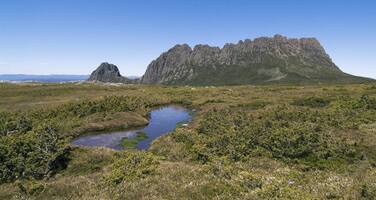Tasmanian Wilderness
Factors affecting the property in 1996*
- Forestry /wood production
- Ground transport infrastructure
Factors* affecting the property identified in previous reports
- Potential construction of a dam (issue resolved)
- Commercial logging in areas adjacent to the World Heritage property
- Roading activities adjacent to the site
International Assistance: requests for the property until 1996
Total amount approved : 0 USD
Missions to the property until 1996**
Information presented to the Bureau of the World Heritage Committee in 1996
This mixed site was inscribed on the World Heritage List in 1982. The Bureau (July 1994) previously discussed reports received on logging operations in adjacent areas. The Committee (1995) noted that the national authorities have provided information that negotiations to alleviate possible impacts are still underway. The authorities informed the Centre that a preliminary assessment of World Heritage values was undertaken in adjacent areas, the 'Interim Forest Assessment'. The outcome of the Interim Forest Assessment negotiations between the Commonwealth and Tasmanian Governments was, that of the eight coupes identified in the study, five were protected from logging and three were made available for timber harvesting. Subsequent stages of the comprehensive regional assessment process have begun. The scoping agreement of January 1996 includes a commitment to undertake World Heritage assessments for all forested areas within Tasmania including the Tarkine region. Discussions are now underway with Tasmania to develop a methodology for the proposed World Heritage assessments, involving both natural and cultural values.
Action Required
The Bureau commended the State Party for its efforts to carry out the preliminary assessment of World Heritage values in areas adjacent to the World Heritage site. It requested the Australian authorities to provide a full report once the negotiations and assessment work has been completed.
Summary of the interventions
Decisions adopted by the Committee in 1996
20 BUR IV.7
Tasmanian Wilderness (Australia)
The Bureau recalled previously discussed reports received on logging operations in adjacent areas to the site and was informed that discussions are now underway with Tasmania to develop a methodology for the proposed World Heritage assessments, involving both natural and cultural values.
The Bureau requested the Centre to write a letter to commend the State Party for its efforts to carry out the preliminary assessment of World Heritage values in areas adjacent to the World Heritage site. It requested the Australian authorities to provide a full report once the negotiations and assessment work has been completed.
20 COM VII.D.43
SOC noted by Committee: Australian Natural Sites
VII.43 Australia
IUCN provided additional information on the situation of World Heritage sites in Australia. The Bureau at its twentieth extraordinary session recalled that Australia is a leading State Party in the protection and enhancement of World Heritage. It took note of information provided by IUCN on potential threats at a number of World Heritage sites in Australia, including salt mining at Shark Bay, logging in adjacent areas of the Tasmanian Wilderness, uranium mining at Kakadu National Park, and the opening of nature reserves at the Great Barrier Reef to fishing and development. IUCN stated that - due to lack of sufficient resources - it was not possible to prepare detailed reports on any of these sites. However, resolutions on two of the sites passed at the World Conservation Congress held in Montreal, Canada, in October 1996 were tabled.
The Delegate of Australia regretted that these reports were not available. Australian authorities report regularly on all their World Heritage areas. She provided information that the Federal Agencies had been restructured and that Australian World Heritage would be strengthened as a result. The Delegate of Australia informed the Committee that the reports received by IUCN were in some cases inaccurate or incomplete and that Australia has taken a number of steps and actions to mitigate the decribed threats to World Heritage Areas. She underlined that Australia had no essential problems with resolutions concerning Australian World Heritage sites passed by the World Conservation Congress held in Montreal, Canada, in October 1996 since most of the proposed actions were already undertaken.
Exports
* :
The threats indicated are listed in alphabetical order; their order does not constitute a classification according to the importance of their impact on the property.
Furthermore, they are presented irrespective of the type of threat faced by the property, i.e. with specific and proven imminent danger (“ascertained danger”) or with threats which could have deleterious effects on the property’s Outstanding Universal Value (“potential danger”).
** : All mission reports are not always available electronically.


